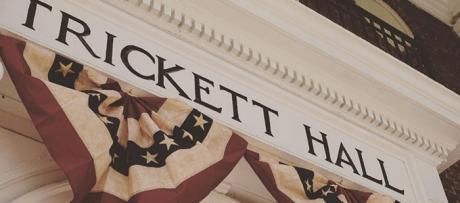A History of Diversity at Dickinson Law

In 1890 The Dickinson School of Law was chartered as an independent institution. The Class of 1892 included the school’s first international student, Issa Tanimura of Tokyo, Japan. While a student, he organized a “Japanese Carnival,” the proceeds of which were used to purchase approximately 800 books for the law school’s library; only one of those books is known to have survived. He never practiced law, but did travel the world representing Japan at international exhibitions and agricultural conferences. It is worth noting that Tanimura attended our school at a time when many Americans, particularly those on the west coast, were seeking to limit or end Asian immigration to the United States.
The school’s first female student was Julia Radle, Class of 1899. While a student, she served as secretary of her class and vice president of the Dickinson Law Society. In 1898, Radle was joined by a second woman, Sara Marvel. Following her graduation, Radle practiced law with her brother until his death; she then went into teaching.
The law school’s first black student may have been Clarence Muse, Class of 1911. He did not graduate, but left after one year to pursue an acting career. Muse went on to appear in 220 motion pictures in a career that lasted over 60 years. A founding member of the Screen Actors Guild, he appeared in the second talking picture ever made, Hearts in Dixie. In 1978 Muse returned to Dickinson Law to receive an honorary Doctor of Laws degree.
However, it is possible that Muse was not our first African-American student; that title might in fact belong to James Phillips, Class of 1903. Phillips is said to have been of mixed Irish, Cherokee, and African-American descent. He was listed as being “mulatto” in the 1880 census. Tom Benjey, author of the book Doctors, Lawyers, Indian Chiefs, reported that he believed that Phillips was Melungeon, a branch of the Cherokee tribe in North Carolina that had intermarried with African-Americans. Before arriving at Dickinson, Phillips attended Lincoln University, an historically black college. However, race was not a factor for admission at Lincoln, so Phillips’ attendance there is not necessarily indicative of his race. During his time in Carlisle he played football for both Dickinson College and the Carlisle Indian Industrial School.
Phillips eventually settled in Aberdeen, Washington. Census records from 1920 on list him as being “white.” However, his brother — who remained on the east coast — was required to register as a black voter. When the registrar requested that the brother recite the Preamble to the U.S. Constitution as part of his voter registration, he reportedly asked whether he should recite it in English, French or Ancient Greek. According to a conversation with Dr. Benjey, Phillips’ modern descendants on the west coast consider themselves to be white; his east-coast relatives consider themselves to be black.
If Phillips is not considered to be our first black student, then our first African-American graduate — since Muse did not graduate — would probably be J. Steward Davis, Class of 1914. According to newspaper accounts, he was valedictorian of his class. Following his graduation, Davis became a respected trial lawyer in Baltimore, Maryland. On April 16, 1929, he disappeared under suspicious circumstances. His biography in the Dickinson yearbook, the Microcosm, describes him as “a through gentleman, congenial, dependable, industrious, conservative, has a good head on him and knows how to use it.”
Henri Charles Rexach from San Juan, Puerto Rico, Class of 1906, might have been our first Hispanic student. The yearbook noted that he was “quite a classical scholar.” Another early student from Puerto Rico was Artemio P. Rodriquez, Class of 1908. Following graduation he returned to Puerto Rico and practiced law in San Juan. His classmates described him as displaying “considerable ability” and being endowed with “an indomitable will.”
The close proximity of the Carlisle Indian Industrial School apparently attracted a number of Native American students to the law school, several of whom also played football at the Indian School. The first of these was Samuel Townsend, Class of 1893. The yearbook indicates that he was a member of the Pawnee Tribe, but provides no additional information about him. He did not graduate from the law school.
Ed Rogers, a member of the Chippewa Tribe, attended the law school during the 1900-01 school year. We know that he did play football at the Indian School. Of course James Phillips, already mentioned, also played football for the Indian Industrial School. Another Native American, Hastings M. Robertson of Allen, South Dakota, was a member of the Class of 1907.
William J. Gardner, a member of the Chippewa Tribe, graduated from the law school in 1909. He played football at the Indian School while a law student, and played professional football following his graduation. He later served as one of the celebrated “Untouchables” who fought Chicago mob boss Al Capone during the Prohibition era.
Other Native Americans who attended the law school included Victor Kelley (Choctaw, ex-1911); Albert Exendine (Delaware and Cherokee, Class of 1913; and Gustavus “Gus” Welch (Chippewa, Class of 1917).
This information is largely compiled from old yearbooks, hence the use of such terms as “might” and “possibly.” We have no admission or academic records from this period; they were either destroyed or never existed.